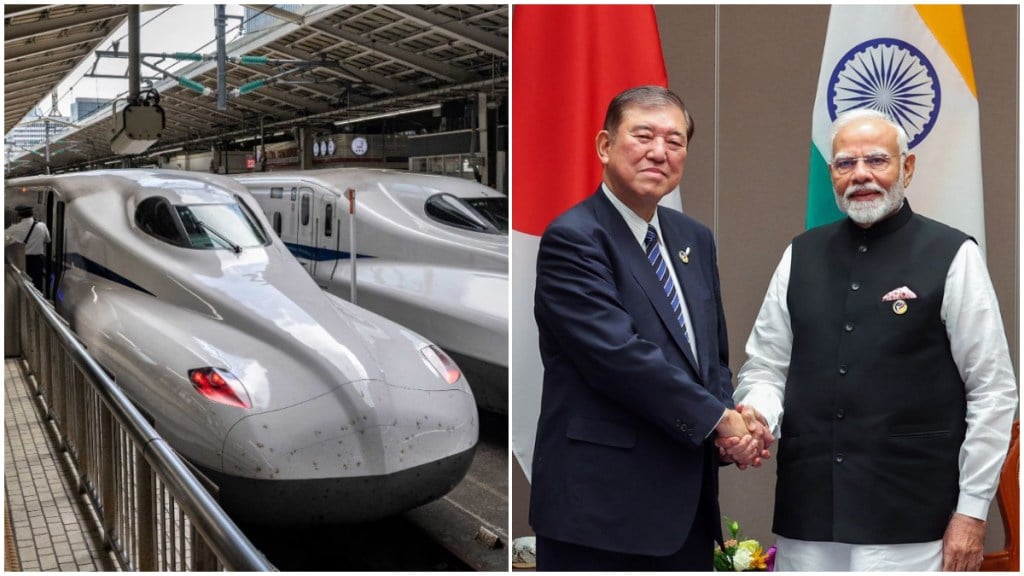Prime Minister Narendra Modi will be meeting his Japanese counterpart Shigeru Ishiba on Friday for the 15th India-Japan annual summit. This will be his first solo visit to Japan in nearly seven years and also his first meeting with Ishiba. The two leaders are expected to discuss a spectrum of projects and sectors such as infrastructure, energy, defence, security, trade, economy, technology and innovation. One of the key deals that the two PMs are likely to announce is their partnership for manufacturing the next generation E10 Shinkansen bullet trains in India.
Modi may bring Japan’s next-gen E10 Shinkasen Bullet Trains to India
India is likely to procure Japan’s E10 series bullet trains, which run at 320 km/h, are earthquake-safe, and come with advanced safety systems. The upcoming E10 can reach a speed of 400 km/h. The E10 is still being tested in Japan and is expected to start operations in 2030. Japan has been using the ALFA-X train as a testing platform for new technologies for its development. Both leaders will also visit the Tohoku Shinkansen plant in Sendai to see how bullet train coaches are made.
The E10 Shinkansen project is likely to be part of a new transport and mobility partnership between India and Japan. Earlier this year, Tokyo agreed that India and Japan will launch the latest E10 Shinkansen at the same time. India was earlier supposed to get the older E5 model, but reportedly, PM Modi’s strong push for the project and his close ties with Japanese leaders helped secure the newer version.
Expanding Bullet Train route in India, beyond Mumbai-Ahmedabad
High-speed rail is definitely going to be a key topic. Japan already has a big hand in developing the Mumbai-Ahmedabad bullet train project in India. However, the talks may cover extending the network to other routes in the country.
Push for semiconductors and electronics
The summit will focus on semiconductors and electronic manufacturing. Modi and Ishiba will jointly tour the Tokyo Electron Factory, a leading Japanese firm in chipmaking.
Japan plans to invest heavily in semiconductors and AI over the next decade, and part of this expansion will include working with Indian talent and companies. The move is expected to strengthen supply chains and also secure critical minerals.
Developing AI and digital partnerships
Artificial intelligence is going to be another major focus area for Modi-Ishiba talks. Both countries are expected to launch a joint initiative to build AI tools, support startups, and share expertise for building and expanding the digital infrastructure. Other discussions may cover telecom technologies and clean energy innovations, with the motive of helping India expand its digital economy.
Defence and security cooperation
Defence talks are expected to deepen cooperation in advanced technologies. The UNICORN radar and communication project is expected to move forward, boosting India’s naval systems.
The two countries may also collaborate on ship maintenance and jointly develop defence equipment. An upgrade of the 2008 security agreement is also likely, including work on cybersecurity and maritime security.
Space partnership
Space will also be part of the talks. India’s ISRO and Japan’s JAXA will continue work on the Lunar Polar Exploration Mission (LUPEX), linked to Chandrayaan-5. This project may open opportunities for Indian startups to use Japanese technology for future space missions.
India, Japan to push investments beyond set target
India and Japan are all set to upgrade their 2008 Joint Declaration on Security Cooperation and review progress in defence and technology transfer. The two PMs are also expected to launch a new economic security initiative covering semiconductors, critical minerals, artificial intelligence, telecom, and clean energy. Both countries see this as the “backbone” of their partnership in economy, science, and technology.
The two leaders will also push for higher Japanese investments in India. The earlier target was 5 trillion yen in public and private investments by 2026, but that figure has already been met in 2025. Now, both sides are likely to raise the target to 7-10 trillion yen.


